India and the United States have accelerated discussions to establish six nuclear reactors as part of the Kovvada nuclear project in Andhra Pradesh‘s Srikakulam district. This collaboration involves American power giant Westinghouse Electric Company (WEC). Additionally, the two nations are exploring the joint development of next-generation, small-modular reactor technologies for both the domestic market and export purposes.
During Prime Minister Narendra Modi’s state visit to the US, these topics were brought up in discussions between him and President Joe Biden. The official statement issued at the end of their talks highlighted the crucial role of nuclear energy in global decarbonization efforts. It emphasized that nuclear power is a necessary resource to meet the climate, energy transition, and energy security needs of both countries.
The statement acknowledged the ongoing negotiations between the Nuclear Power Corporation of India Limited (NPCIL) and Westinghouse Electric Company (WEC) for the construction of the six nuclear reactors in India. Both leaders welcomed the increased consultations between the US Department of Energy (DOE) and India’s Department of Atomic Energy (DAE) to facilitate opportunities for WEC in developing a techno-commercial offer for the Kovvada nuclear project.
Furthermore, India and the US are actively discussing the collaborative development of next-generation, small-modular reactor technologies for the domestic market and potential exports. This collaborative effort signifies the intent to leverage advanced nuclear technologies for sustainable and secure energy solutions.
The statement also reaffirmed the United States’ support for India’s membership in the Nuclear Suppliers Group (NSG) and committed to continuing engagement with like-minded partners to advance this goal. Membership in the NSG would provide India with access to global nuclear trade, enabling it to enhance its nuclear capabilities and contribute to non-proliferation efforts.
India currently operates 22 reactors with an installed capacity of 6,780 MWe. Among these, 18 reactors are Pressurized Heavy Water Reactors (PHWRs), and four are Light Water Reactors (LWRs). The country has nine nuclear-power reactors under construction, expected to be completed by 2024-25. In addition, administrative approval and financial sanction were granted in June 2017 for an additional 12 reactors.
By 231, India envisions the completion of 21 upcoming nuclear-power reactors with an installed capacity of 15,700 MW. Moreover, discussions are underway to finalize proposals for the establishment of large-size Light Water Reactors in collaboration with France at the Jaitapur site in Maharashtra and with the USA at the Kovvada site in Andhra Pradesh. The cost of these reactors will be determined after the formalization of proposals and subsequent techno-commercial discussions.
The fast-tracking of talks between India and the US for the Kovvada nuclear project demonstrates the commitment to expand India’s nuclear energy capabilities and promote clean and sustainable power generation. This collaboration not only enhances India’s energy security but also contributes to global efforts in mitigating climate change by reducing carbon emissions through the deployment of nuclear energy technologies.
Background: Delayed Project of Kovvada Nuclear Power Plant and Westinghouse
As has been reported earlier, the project to establish a nuclear power plant in Kovvada, Andhra Pradesh, has experienced significant delays primarily due to the involvement of Westinghouse Electric Company (WEC). The project, which aims to construct six nuclear reactors, has faced numerous challenges and setbacks, leading to a prolonged timeline for its completion.
One of the major factors contributing to the delay was the financial troubles faced by Westinghouse itself. Financial Express Online has reported that in 2017 Westinghouse had filed for bankruptcy due to cost overruns and delays in the construction of two reactors in the United States. This bankruptcy filing created uncertainties and raised concerns about the company’s ability to fulfill its commitments and obligations for international projects, including the Kovvada nuclear project in India.
As a result of the bankruptcy, the negotiations and discussions between Westinghouse and the Nuclear Power Corporation of India Limited (NPCIL) came to a standstill. The financial instability of Westinghouse posed a significant risk to the progress of the project, as it created doubts about the company’s capability to provide the necessary technology, expertise, and financial resources for the construction of the nuclear reactors.
Furthermore, the delays were compounded by the complex nature of nuclear power projects. Constructing nuclear reactors involves stringent safety measures, regulatory approvals, environmental clearances, and intricate engineering processes, all of which contribute to an extended timeline. Additionally, the involvement of multiple stakeholders, both domestic and international, necessitates extensive coordination and alignment of interests, further contributing to delays.
The project faced further complications due to issues related to land acquisition and local opposition. Land acquisition is a crucial aspect of any large-scale infrastructure project, and delays or disputes in this process can significantly impact the project’s progress. The local communities and environmental activists raised concerns about the potential environmental impacts and safety risks associated with the establishment of a nuclear power plant in the region. These concerns led to protests, legal battles, and additional hurdles that further slowed down the project.
To address these challenges and expedite the project, both sides have engaged in intensified consultations and negotiations. The discussions aim to find solutions to the financial, technological, and regulatory issues associated with the project. The recent fast-tracking of talks between the two countries demonstrates their commitment to overcoming the delays and moving forward with the establishment of the Kovvada nuclear power plant.
While the delays caused by Westinghouse’s financial difficulties have been a significant factor in the project’s slow progress, the collaborative efforts between India and the United States indicate a renewed commitment to realizing the project’s objectives. The focus is now on finding viable solutions, ensuring financial stability, streamlining regulatory processes, addressing environmental concerns, and leveraging advanced nuclear technologies to advance clean and sustainable energy generation in India.
